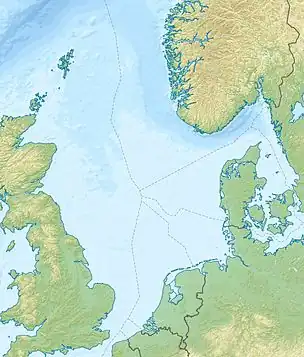| Fulmar Oil Field | |
|---|---|
 | |
| Country | Scotland, United Kingdom |
| Region | Central North Sea |
| Block | 30/16, 30/11b |
| Offshore/onshore | offshore |
| Coordinates | 56°29′00″N 2°8′00″E / 56.48333°N 2.13333°E |
| Operator | Repsol Sinopec Resources UK Ltd.[1] |
| Field history | |
| Discovery | 1975 |
| Start of production | 1982 |
| Production | |
| Estimated oil in place | 73.42 million tonnes (~ 85.56×106 m3 or 538.2 million bbl)[2] |
| Estimated gas in place | 4.09×109 m3 (144×109 cu ft) |
| Producing formations | Upper Jurassic Fulmar Sandstone |
The Fulmar Oilfield is situated 312 km east of Dundee, Scotland, United Kingdom in block number 30/16 and 30/11b. It is operated by Repsol Sinopec who took over from the previous operator, Shell at the end of 2006. At this time Talisman also purchased the equity of the other partners ExxonMobil and Amerada Hess. The field was discovered in December 1975 by well 30/16-6 in a water depth of 82 metres. Estimated ultimate recovery is 544 million barrels (86.5×106 m3) of oil. It is named after the fulmar, a sea bird.
The oil reservoir is located at a depth of 3,050 metres.
The "Fulmar A platform" operates above the oilfield. Production started in February 1982 from the Fulmar 'A' platform. This platform is a steel, 8 legged jacket designed by McDermott Engineering and constructed at Nigg, Easter Ross, Scotland. This jacket weighs 12,400 tonnes and supports a topside weight of around 22,560 tonnes. The jacket and platform were installed in July 1979 and June 1980.[3]
Design data for the installations in the Fulmar field is summarized below.[4]
| Installation | Fulmar A | Fulmar AR | Fulmar mooring terminal | Fulmar FSU |
|---|---|---|---|---|
| Type | Steel jacket | Steel jacket bridge link to Fulmar A | Single Anchor Leg Mooring (SALM) | Tanker |
| Function | Drilling, production, accommodation | Wellhead | Loading tankers | Oil storage |
| Location | 56°29’37”N 02°09’17”E | 56°28’38”N 02°07’54”E | 56°28’38”N 02°07’54”E | |
| Water depth, metres | 83.5 | 83.5 | 82 | 82 |
| Fabrication substructure | Highlands Fabricators Nigg | Redpath, Methil | RSV Rotterdam | Mitsubishi Japan, converted by CNC |
| Topsides design | McDermott, London | McDermott, London | Exxon Production Research | CNC France |
| Topside weight, tonnes | 22,030 | 260 | 1966 | 210,658 (DWT) |
| Storage, barrels | – | – | Nil | 1,368,247 |
| Accommodation (crew) | 240 | Nil | Nil | 91 |
| Legs | 8 | 4 | 1 | – |
| Piles | 32 | 8 | 6 | – |
| Well slots | 36 | 6 | – | – |
| Wells | 16 production, 10 water injection, 2 gas injection | 5 | – | – |
| Throughput oil, barrels per day (bpd) | 180,000 | 90,000 | 180,000 | |
| Water injection, bpd | 20,000 | – | – | – |
| Platform installed | June 1980 | June 1979 | May 1981 | May 1981 |
| Production start | May 1982 | February 1982 | May 1982 | May 1982 |
| Oil production to | SALM by 2.3 km 16-inch pipeline (1982) | Fulmar A | Tanker | SALM |
| Gas production to | St Fergus by 290 km 20-inch pipeline (1986) | – | – | – |
The topsides facilities included capability to drill, produce, meter, pump oil and gas. It can also inject both gas and water. Production is exported via the Norpipe system to Teesside.
Associated natural gas from the reservoir is separated and used to power electrical generation with the excess being transported by the Fulmar Gas Pipeline to St. Fergus.
Previously oil was exported by using an oil tanker anchored to the sea bed. The Medora Floating Storage Offloading (FSO) vessel broke free on the evening of 24 December 1988 narrowly missing the BP operated Clyde platform in the process.[5]
At that time Fulmar Alpha was host to a BBC crew who, not only, reported on the event but later delivered a live watchnight service broadcast from the platform in memory of the Piper Alpha disaster.[6] Some of the same BBC crew having come directly from reporting on the Lockerbie disaster.[7]
See also
References
- ↑ DECC Fields Index Archived March 12, 2012, at the Wayback Machine
- ↑ DTI Brown Book 2001 Archived 2001-11-14 at the Wayback Machine
- ↑ Department of Trade and Industry (1994). The Energy Report. London: HMSO. p. 141. ISBN 0115153802.
- ↑ Oilfield Publications Limited (1985). The North Sea Platform Guide. Ledbury: Oilfield Publications Limited. pp. 255–261.
- ↑ "On This Day: Oilfields crippled after storage ship drifts". BBC News. 24 December 1988. Retrieved 19 September 2010.
- ↑ "On This Day: Dozens feared dead in Piper Alpha oil blaze". BBC News. 6 July 1988. Retrieved 19 September 2010.
- ↑ "On This Day : Jumbo jet crashes onto Lockerbie". BBC News. 21 December 1988. Retrieved 19 September 2010.